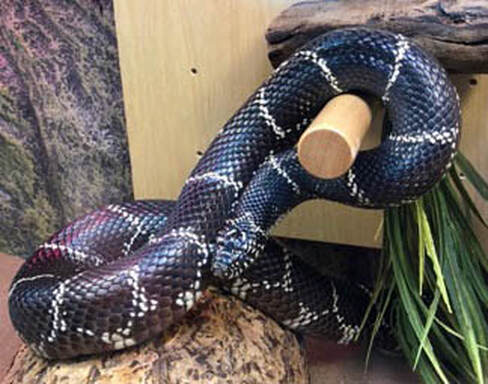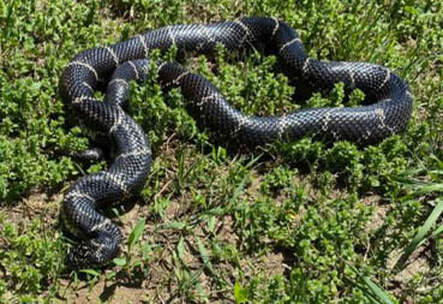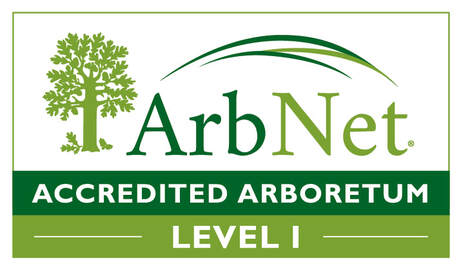Eastern Kingsnake (Lampropeltis getula getula)
|
YPhysical Description: Eastern Kingsnakes grow between three and four feet long and weigh 4 lbs. on average. The Eastern Kingsnakes have glossy scales that form two-color bandings, black and white or yellow. The Eastern Kingsnake has about 30 bands. The head is black with white or yellow speckled scales. The underbelly is pale yellow with alternating patterns of black scales in a “zigzag” pattern.
Habitat: Eastern Kingsnakes inhabit pinelands, hardwood hammocks, prairies, marshes, and estuaries. |
Range: The Eastern Kingsnake ranges from southern New Jersey to northern Florida, and west to Alabama.
Diet: They are carnivores who will eat reptiles, amphibians, birds, and small mammals. They will also eat other snakes, including rattlesnakes, as they are resistant to their venom. The Eastern Kingsnake is a nonvenomous constrictor; they seize prey with their jaws and wrap tightly around the animal, squeezing until it dies. The snake then swallows the prey whole.
Lifespan: They live 9 years on average in the wild and up to 33 in human care.
Social Structure: The Eastern Kingsnake is a solitary creature outside of their breeding season. The female chooses a nesting site in rotting logs or piles of sawdust. She will lay a clutch between 3 to 29 eggs in a single breeding season. The incubation temperature of the nest determines the gender of the offspring with warmer temperatures producing males and cooler temperatures producing females. When the snakes hatch, they are fully formed, totally independent and are 8 to 11 inches long. They tend to stay in the nest for the first week until their first skin shed.
Status: Least Concern1
Other: Like many types of snakes, they will also emit an unpleasant musk and flee rather than fight when threatened.
1 https://www.iucnredlist.org/species/67662588/67662645
Diet: They are carnivores who will eat reptiles, amphibians, birds, and small mammals. They will also eat other snakes, including rattlesnakes, as they are resistant to their venom. The Eastern Kingsnake is a nonvenomous constrictor; they seize prey with their jaws and wrap tightly around the animal, squeezing until it dies. The snake then swallows the prey whole.
Lifespan: They live 9 years on average in the wild and up to 33 in human care.
Social Structure: The Eastern Kingsnake is a solitary creature outside of their breeding season. The female chooses a nesting site in rotting logs or piles of sawdust. She will lay a clutch between 3 to 29 eggs in a single breeding season. The incubation temperature of the nest determines the gender of the offspring with warmer temperatures producing males and cooler temperatures producing females. When the snakes hatch, they are fully formed, totally independent and are 8 to 11 inches long. They tend to stay in the nest for the first week until their first skin shed.
Status: Least Concern1
Other: Like many types of snakes, they will also emit an unpleasant musk and flee rather than fight when threatened.
1 https://www.iucnredlist.org/species/67662588/67662645








